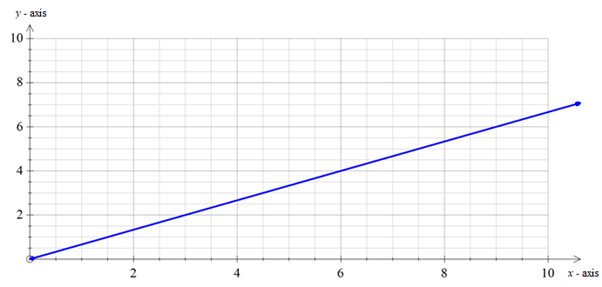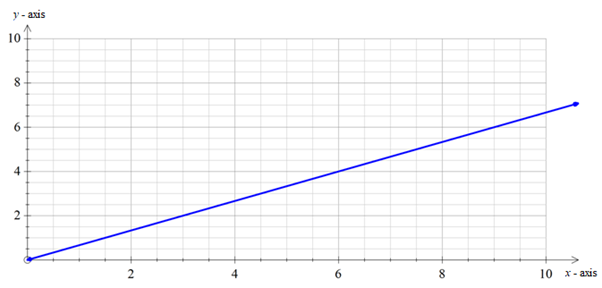
Concept explainers
a
To make a table showing the relation between body and water weight for people weighing 100, 105, 110,120,125 and 130 pounds.
a
Explanation of Solution
Given:
The given relation is
Where w = weight of water in pounds.
b = body weight in pounds.
Calculation:
When the body weight ( b) =100 pounds, weight of water ( w ) is =
Similarly,
| Values of ‘ b’ | Values of ‘ w’ |
| 100 | |
| 105 | |
| 110 | |
| 120 | |
| 125 | |
| 130 |
Conclusion:
The above table shows the relation between body and water weight for people.
b
To identify the dependent and independent variables from the given relation.
b
Answer to Problem 6CB
Weight of body is independent variable.
Weight of water is dependent variable.
Explanation of Solution
Given:
The given relation is
Independent variables are those variables which keeps on changing and they are unaffected by the change of any other parameter. For example: - Time.
Hence, Weight of the body ( b) is the deciding parameter which does not depend on other variable. So it is the independent variable.
Weight of the water ( w) depends on weight of the body ( b) as per the given relation.
So, the Weight of the water is the dependent variable.
Conclusion:
Therefore, weight of body is independent variable and weight of water is dependent variable.
c
To write: the domain and range of the relation
c
Answer to Problem 6CB
Domain
Range
Explanation of Solution
Given:
The relation is
Domain is all the values of x - axis that is defined in the given relation.
Range is all the values of y - axis that are possible for corresponding values of x - axis.
Hence, for the relation
Calculation for graph:
Consider
| Values of ‘ b’ | Values of ‘ w’ |
| 100 | |
| 105 | |
| 110 | |
| 120 | |
| 125 | |
| 130 |
By taking different values of b , the graph can be plotted.
Graph:

Interpretation:
From the above graph, it is clear that,
As the weight of the body increases, the weight of the water also increases.
d
To reverse the independent and dependent variable of the given relation, graph it and interpret the meaning of the graph.
d
Explanation of Solution
Given:
The relation is
Here, Weight of the body ( b ) is the independent variable.
Weight of water ( w) is the dependent variable
The given relation after reversing the independent and dependent variable is
This means, for every 3 pounds of water, there will be 2 pounds of body weight for an adult.
Calculation for graph:
Consider
| Values of ‘ w’ | Values of ‘ b’ |
| 100 | |
| 105 | |
| 110 | |
| 120 | |
| 125 | |
| 130 |
Graph:
 In the above graph, x - axis denotes the weight of the water ( w) in pounds.
In the above graph, x - axis denotes the weight of the water ( w) in pounds.
y - axis denotes the weight of the body ( b ) in pounds.
Interpretation:
From the above graph, it is clear that,
As the weight of the water increases, the weight of the body also increases.
Chapter 1 Solutions
High School Math 2011 Algebra 1(prentice Hall) Student Edition
Additional Math Textbook Solutions
Introductory Statistics
Thinking Mathematically (6th Edition)
A Problem Solving Approach To Mathematics For Elementary School Teachers (13th Edition)
Calculus: Early Transcendentals (2nd Edition)
Elementary Statistics (13th Edition)
A First Course in Probability (10th Edition)
- 1. Given that h(t) = -5t + 3 t². A tangent line H to the function h(t) passes through the point (-7, B). a. Determine the value of ẞ. b. Derive an expression to represent the gradient of the tangent line H that is passing through the point (-7. B). c. Hence, derive the straight-line equation of the tangent line H 2. The function p(q) has factors of (q − 3) (2q + 5) (q) for the interval -3≤ q≤ 4. a. Derive an expression for the function p(q). b. Determine the stationary point(s) of the function p(q) c. Classify the stationary point(s) from part b. above. d. Identify the local maximum of the function p(q). e. Identify the global minimum for the function p(q). 3. Given that m(q) = -3e-24-169 +9 (-39-7)(-In (30-755 a. State all the possible rules that should be used to differentiate the function m(q). Next to the rule that has been stated, write the expression(s) of the function m(q) for which that rule will be applied. b. Determine the derivative of m(q)arrow_forwardSafari File Edit View History Bookmarks Window Help Ο Ω OV O mA 0 mW ర Fri Apr 4 1 222 tv A F9 F10 DII 4 F6 F7 F8 7 29 8 00 W E R T Y U S D பட 9 O G H J K E F11 + 11 F12 O P } [arrow_forwardSo confused. Step by step instructions pleasearrow_forward
- In simplest terms, Sketch the graph of the parabola. Then, determine its equation. opens downward, vertex is (- 4, 7), passes through point (0, - 39)arrow_forwardIn simplest way, For each quadratic relation, find the zeros and the maximum or minimum. a) y = x 2 + 16 x + 39 b) y = 5 x2 - 50 x - 120arrow_forwardIn simplest terms and step by step Write each quadratic relation in standard form, then fi nd the zeros. y = - 4( x + 6)2 + 36arrow_forward
- In simplest terms and step by step For each quadratic relation, find the zeros and the maximum or minimum. 1) y = - 2 x2 - 28 x + 64 2) y = 6 x2 + 36 x - 42arrow_forwardWrite each relation in standard form a)y = 5(x + 10)2 + 7 b)y = 9(x - 8)2 - 4arrow_forwardIn simplest form and step by step Write the quadratic relation in standard form, then fi nd the zeros. y = 3(x - 1)2 - 147arrow_forward
- Step by step instructions The path of a soccer ball can be modelled by the relation h = - 0.1 d 2 + 0.5 d + 0.6, where h is the ball’s height and d is the horizontal distance from the kicker. a) Find the zeros of the relation.arrow_forwardIn simplest terms and step by step how do you find the zeros of y = 6x2 + 24x - 192arrow_forwardStep by step Find the zeros of each quadratic relation. a) y = x2 - 16xarrow_forward
 Algebra and Trigonometry (6th Edition)AlgebraISBN:9780134463216Author:Robert F. BlitzerPublisher:PEARSON
Algebra and Trigonometry (6th Edition)AlgebraISBN:9780134463216Author:Robert F. BlitzerPublisher:PEARSON Contemporary Abstract AlgebraAlgebraISBN:9781305657960Author:Joseph GallianPublisher:Cengage Learning
Contemporary Abstract AlgebraAlgebraISBN:9781305657960Author:Joseph GallianPublisher:Cengage Learning Linear Algebra: A Modern IntroductionAlgebraISBN:9781285463247Author:David PoolePublisher:Cengage Learning
Linear Algebra: A Modern IntroductionAlgebraISBN:9781285463247Author:David PoolePublisher:Cengage Learning Algebra And Trigonometry (11th Edition)AlgebraISBN:9780135163078Author:Michael SullivanPublisher:PEARSON
Algebra And Trigonometry (11th Edition)AlgebraISBN:9780135163078Author:Michael SullivanPublisher:PEARSON Introduction to Linear Algebra, Fifth EditionAlgebraISBN:9780980232776Author:Gilbert StrangPublisher:Wellesley-Cambridge Press
Introduction to Linear Algebra, Fifth EditionAlgebraISBN:9780980232776Author:Gilbert StrangPublisher:Wellesley-Cambridge Press College Algebra (Collegiate Math)AlgebraISBN:9780077836344Author:Julie Miller, Donna GerkenPublisher:McGraw-Hill Education
College Algebra (Collegiate Math)AlgebraISBN:9780077836344Author:Julie Miller, Donna GerkenPublisher:McGraw-Hill Education





